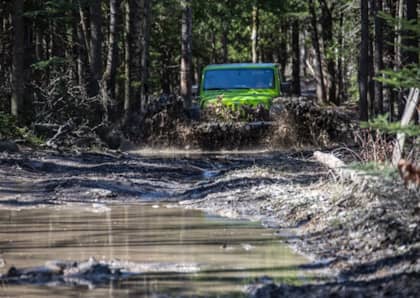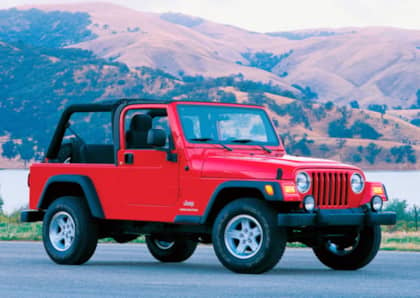A History Of The Jeep Wrangler TJ, Chrysler's First Modern 4x4 That Birthed The Rubicon
Thanks in part to a late-1980s redesign that transformed its go-anywhere off-roader into a cultural phenomenon (the Wrangler YJ), Jeep had made significant in-roads into the automotive mainstream. With a '90s line-up that now included the family-friendly Grand Cherokee alongside the still-popular compact Cherokee SUV, it was time to give the Wrangler another strong push into the spotlight.

The Jeep Wrangler TJ arrived in 1997, a full ten years after the original model. It represented the first Wrangler to be developed using the full resources of parent company Chrysler, which was a significant step up over the shallow pockets of previous AMC ownership. Not only did it bring with it a revolutionary improvement in chassis design, but it also righted a historical wrong that had sent Jeep purists into a tizzy about its YJ ancestor.
Square Headlights, Strong Suspension
The 1997 Jeep Wrangler TJ made absolutely certain to re-introduce round headlights in place of the YJ's square units. This was a far bigger deal than it might at first seem: the YJ had been pilloried by Jeep fans who were disappointed that the brand strayed from decades of tradition by installing right-angle lights in what had previously been a circular styling zone.

With that major oversight corrected, Jeep's engineering team could concentrate on other, arguably more important aspects of the TJ's evolution. Specifically, the new Wrangler focused on delivering an even better on-pavement ride, which was achieved on a somewhat shoestring budget of $260 million—a sum that indicated Jeep was comfortable keeping the Wrangler's basic frame intact.

The rest of the chassis, however, was up for grabs. The TJ swapped in coil springs for leaf units and added four-link control arms, which dramatically boosted control and comfort. The setup was borrowed for the most part from the grand Cherokee, and included an anti-roll bar and track bar, with a choice of multiple shock options. The existing frame was stiffened, which when matched with the vehicle's replacement steel body panels (themselves boasting a startling 100 percent increase in torsional rigidity), translated into a truck that was a third stiffer overall than the departing YJ.

The coil springs weren't just about keeping the eggs from cracking on the way home from the grocery store. Combined with its retained live axles front and rear, the TJ also delivered much better articulation. Anti-lock brakes were more available, and buyers could choose between manual and power steering.

Despite being completely new, the TJ's body was almost a dead ringer for the older Wrangler. This was by design; Jeep wasn't going to take a chance on upsetting its loyal customers with yet another original idea. Careful tweaks, however, decreased drag considerably, which made for a quieter and somewhat more fuel efficient driving experience. The interior remained roughly the same as well, although equipment levels began to creep up as the TJ moved through time.

If there was one aspect of the Wrangler TJ that remained almost untouched, it was the real estate under its hood. Initially, the SUV carried over both its unkillable 4.0L inline six-cylinder engine and 2.5L four-cylinder from the YJ, where they produced up to 190 hp and 140 hp, respectively. Transmission choices included a 3-speed automatic and 5-speed manual, with a 4-speed autobox arriving in 2003 and a 6-speed manual in 2004. Also new for 2003 was a 2.4L four-cylinder engine that provided just under 150 hp, replacing the AMC-sourced entry-level engine.
The Birth Of The Rubicon
As with the YJ, Jeep made sure to push the TJ's trims and packages into as many different niches as possible, expanding the Wrangler's customer reach like never before. Popular models included the affordable X and Sport (with the latter adding a Dana 44 rear axle), as well as the well-equipped Sahara. Multiple anniversary editions were released, along with the throwback Willys and Golden Eagle (think decals), and the unusual Tomb Raider movie and Columbia clothing tie-ins.

The TJ also brought two major additions to the Wrangler universe to life. When the Jeep was given a refresh for 2003, on top of its new four-cylinder engine and tweaked interior it also introduced the Rubicon, the first version of the hardcore off-roading package that continues to this day. Featuring the brand's new 'Rock-Trac' crawler four-wheel drive system, a pair of locking Dana 44 axles, and a host of upgrades, the Rubicon was an instant success with buyers.

Just as important to the Wrangler's future was the 'LJ' or 'Long Jeep' model. Officially dubbed the 'Unlimited,' it stretched the Jeep's platform by a whopping 15 inches (10 inches of which was wheelbase), dramatically improving interior room and cargo space while also helping to stabilize the vehicle on the road and when tackling steep trails. The TJ Unlimited kept its two-door form-factor, but it set the table for the four-door Wrangler that became a runaway success with the next-generation model.
The Wrangler That’s 'Just Right'
The Jeep Wrangler TJ represents the sweet spot of the 4x4's model history for many fans. More comfortable and compliant day-to-day than the YJ, but smaller and lighter than the JK that came after it, it also has the advantage of ultra-reliable AMC mechanicals, incredible aftermarket support, and improved off-road acumen.

Much as the YJ had done before it, the Wrangler TJ further cemented the off-roader's place as the prince of the Jeep showroom, the vehicle around which all other models orbited and helping to draw many customers to the brand. It's one the best examples of balancing automotive heritage with the realities of modern safety and drive expectations.











